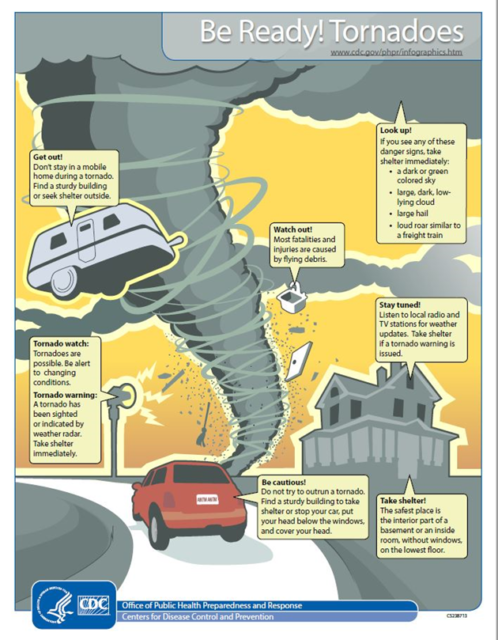Be Ready! Tornadoes
No one can know a tornado’s strength before it touches down, so keep up with local weather information, especially when thunderstorms are forecast. Prepare your home and family for the possibility of a tornado. Moving to shelter quickly is easier when everyone knows where to go, whether in your home or outdoors.
Be sure your children know what a tornado is, what tornado watches and warnings are, what county they live in (warnings are typically issued by county), and what makes a location a safe shelter, whether at home or at school.

Here are three important tips to help keep you and your family safe.
1) Be prepared.
The best way to stay safe during a tornado is to be prepared with:
- A battery-powered TV, radio, or internet-enabled device to listen to the latest emergency weather information (and don’t forget to include fresh batteries).
- A tornado emergency plan including access to a safe shelter for yourself, your family, and for people with special needs.
- An emergency kit (including water, non-perishable food, and medication).
- A list of important information, including telephone numbers.
2) Stay aware of weather conditions.
To protect yourself and your family from harm during a tornado, pay close attention to changing weather conditions in your area. If you know thunderstorms are expected, stay tuned to local radio and TV stations or a NOAA weather radio for further weather information. Some tornadoes strike rapidly without time for a tornado warning.
The following weather signs may mean that a tornado is approaching:
- A dark or green-colored sky.
- A large, dark, low-lying cloud.
- Large hail.
- A loud roar that sounds like a freight train.
- If you notice any of these conditions, take cover immediately, and keep tuned to local radio and TV stations or to a NOAA weather radio or check the internet.
3) Know where to shelter.
Falling and flying debris cause most deaths and injuries during a tornado. Although there is no completely safe place during a tornado, some locations are much safer than others.
- Go to the basement or an inside room without windows on the lowest floor (bathroom, closet, center hallway).
- Avoid windows.
- For added protection get under something sturdy (a heavy table or workbench). Cover your body with a blanket, sleeping bag or mattress. Protect your head with anything available.
- Do not stay in a mobile home.
- If you are outside or in a mobile home, find a nearby building preferably with a basement. If you are in a car, do not try to outrun a tornado but instead find the nearest sturdy building.
Remember: To stay safe during a tornado, prepare a plan and an emergency kit, stay aware of weather conditions during thunderstorms, know the best places to shelter both indoors and outdoors, and always protect your head.
This information is courtesy of the Centers for Disease Control and Prevention (CDC). You may learn more and stay up to date by visiting https://www.cdc.gov/disasters/tornadoes/prepared.html.

